
The turbine was deployed 31 May near Brewer, Maine, USA, by the University of Maine, leader of the DeepCwind Consortium, which also includes Ashland and PPG.
|
The DeepCwind Consortium's mission is to establish the State of Maine as a national leader in deepwater offshore wind technology through a research initiative funded by the US Department of Energy, the National Science Foundation, and others. The University of Maine-led consortium includes:
|
The prototype turbine VolturnUS 1:8 is approximately 65 ft tall. The composite tower – believed to be a first for the wind energy industry – was manufactured by Ershigs, a specialist in corrosion-resistant composite products, and is constructed from Ashland’s Aropol unsaturated polyester resins and PPG Industries' glass fibre reinforcement.
The composite tower is fixed to a polymer concrete floating base.
Compared to a traditional steel tower, a composite tower offers significant weight savings and reduced maintenance related to improved corrosion resistance, Ashland reports.
The 1:8 scale VolturnUS 1:8 is modeled after the 6 MW VolturnUS offshore floating wind turbine that the University of Maine's Advanced Structures and Composites Center plans to launch in the coming years.
- For further information see: First grid-connected offshore wind turbine in North America launched.



